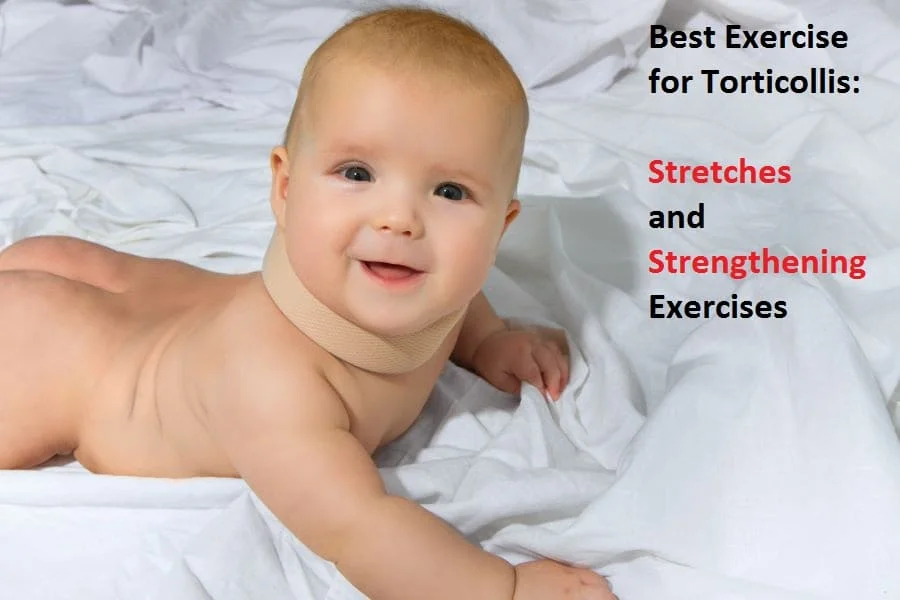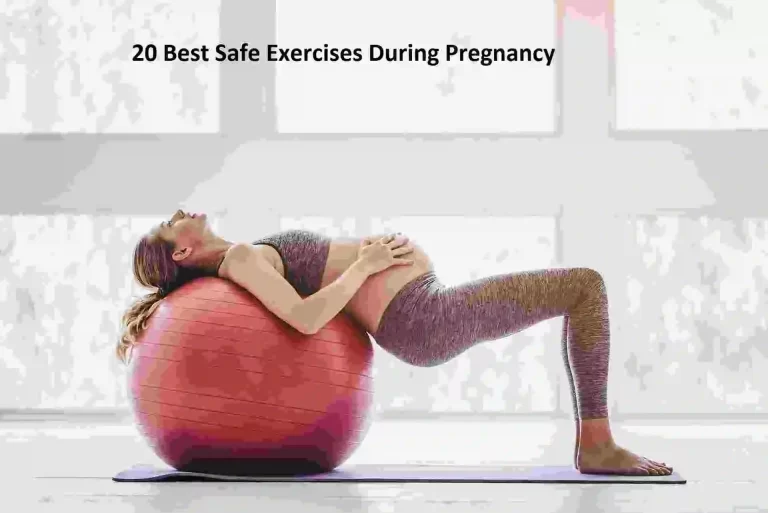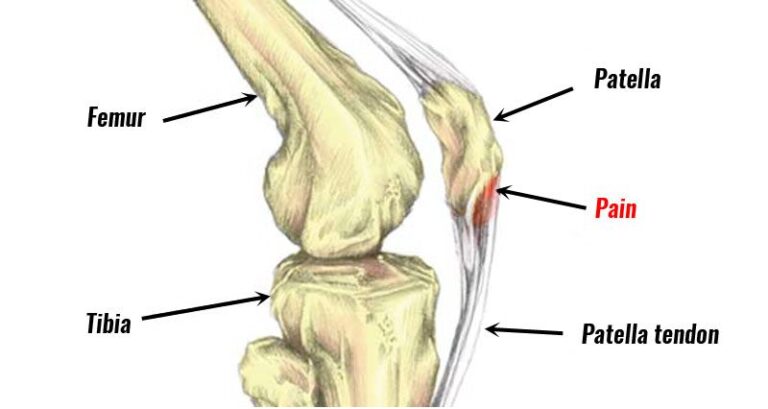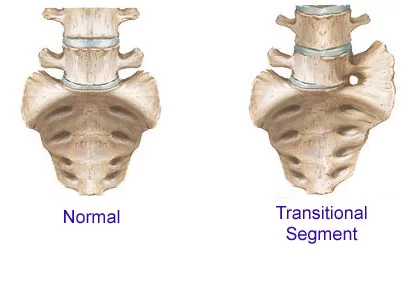13 Best Exercise for Torticollis
Exercise for Torticollis is an essential part of the overall treatment program to correct the deformities, along with neck braces and supportive medical treatment.
Table of Contents
Introduction
Torticollis occurs when your baby’s neck muscles cause his head to twist and turn to the side. Also called Wryneck. It can be congenital or acquired. Symptoms include neck muscle stiffness and swelling. there are many types of torticollis so symptoms of torticollis depend on the type of this condition. Treatment usually involves gentle muscle stretching and changes in position.
Torticollis is a common diagnosis, and it is estimated that 90 percent of people will experience at least one episode of torticollis in their lifetime. Torticollis can be benign (congenital torticollis), but it can also be caused by serious causes such as brain injury. Longer body length. According to research, babies between 19.7 and 20.4 inches long have an 88% higher risk of developing torticollis.
Torticollis is a condition where the baby’s neck muscles cause his head to twist and tilt to one side. Your baby’s neck may seem twisted at an odd angle. Their head may be tilted to one side and their chin to the other. The Latin words “tortus” meaning twisted and “collum” meaning neck represent the torticollis. Torticollis is quite common in babies and children. Torticollis may be present at birth (congenital). Or it can develop later in infancy or childhood (acquired).
Chronic wry neck can reason of neck pain and difficulty performing neck movements such as side rotation of the neck. at the early stage of this condition medication, and exercises can provide recovery from this condition. Surgery can also sometimes correct the condition. this condition is treated at the early stage of this condition. This is especially true for children.
The most common and common cases seem to be related to dysfunction of local neuromuscular mechanisms (focal dystonia). Cervical dystonia is one of the most common focal dystonias in adults, causing tetanic contraction of the sternocleidomastoid and/or trapezius muscles.
The shape of the neck varies according to the affected muscles. It should be noted that other changes in the position of the head and neck may not be present in torticollis. Sometimes torticollis is developed by a a fixed or dynamic posturing of the head and neck in tilt, rotation, and flexion. Spasms of such muscles sternocleidomastoid, trapezius, and other neck muscles, usually more commonly seen on one side, cause turning or tipping of the head.
In this article, we learn the exercises related to the condition you can learn the stretching exercise which provides flexibility to the shortened muscles Sternocleidomastoid muscle. you can also learn the mobility exercise which provides the normal range of the neck joint with facial symmetry.
Etiology of torticollis
Torticollis has different etiologies. It can be associated with complex and/or serious diseases. There are several types of torticollis:
Congenital torticollis: Trauma can occur during pregnancy or childbirth that causes swelling of the muscle, which can lead to congenital fibrosis of the pectoral muscle, which shortens the fibers of that muscle.
Dermatogenic pain: When the skin of the neck is injured and shortened, it can cause movement limitations, which usually occurs with burns or scars.
Ocular torticollis: This refers to paralysis of the muscles involved in tilting and turning the head (compensation) due to the action of the extraocular oblique muscles.
Rheumatologic torticollis: This variant is secondary to several rheumatologic diseases. Torticollis vestibular: the inner ear responsible for balance, which includes the cochlear labyrinth.
Neurogenic tormentor: This is caused by any neurological disorder or accident, such as a stroke or trauma.
Spastic torticollis (dystonia): This is the most common cause of neck stiffness. This type is caused by increased muscle tone. The most common triggers are mental stress, physical overload, or sudden movement.
Causes of torticollis
Shortening of one of the sternocleidomastoid muscles (SCM) in an infant results in a congenital thyroid muscle. Your SCMs are the two large muscles in your neck. They connect the back of the skull to the sternum (sternum) and clavicle (clavicle). Scientists are not sure why some of these muscles shorten in some children. This may be due to:
- Dystonia
- Sometimes the cause of a wry neck is unknown(idiopathic)
- Some baby position(breech position)in mother’s womb (uterus).
- Abnormal muscle tissue thickening (fibrosis).
- Abnormal development in the sternocleidomastoid muscles
- You have abscesses in your mouth, neck, and head
- Development of mass of blood in your baby’s neck muscles (hematoma).
- some diseases such as Parkinson(cause of muscle spasm)
- Spinal changes, such as disc herniation, scoliosis, and alteration of the C1 & C2 vertebrae in the neck;
- Development of muscle spasm in your neck that may be the cause of injury or trauma to a muscle.
- Klippel-Feil syndrome, vertebrae of the spine become fused in the baby’s birth time
- Certain drugs, such as traditional dopamine receptor blockers (e.g. metoclopramide, phenytoin, or carbamazepine)
Symptoms of torticollis condition:
- Neck stiffness
- Headache
- Fever
- Tremor in head
- Changes in gait pattern
- A tilting of your chin to the affected side
- Pain on one side of your neck
- Occasional formation of a mass
- Thickened or tight sternocleidomastoid muscle
- Tenderness on the cervical spine
- Unequal shoulder heights
- having one shoulder higher than the other
- Asymmetrical facial feature
- Inability to move your head(decreases the range of neck)
Babies with torticollis often have other common symptoms. Parents and carers may notice that their child has:
Problems with bringing the hands to the center of the body.
Delayed visual development (trouble tracking, focusing, and using both eyes together).
Problems in planning movement in space (engine design). Problems with rapid movements (inner ear or balance disorders).
Reflux (stomach acid flows back through the tube connecting the stomach and mouth, causing discomfort after eating).
Decreased sensation in the arm and hand on the opposite side of the strained muscle.
Decreased or limited defensive responses during loss of balance on the stressed side.
Increased lateral flexion of the trunk (bent to one side) on the side of the strained muscle.
Decreased visual tracking (eye movement) to the narrow side.
Loss of muscle strength on the side of the longer muscle (non-long). Late fall on both sides or preferably only on the long (not tight) side.
How is torticollis diagnosed?
If a child is suspected of having torticollis and underlying skeletal abnormalities, an X-ray or magnetic resonance imaging (MRI) may be necessary to confirm the diagnosis.
Medical history
Your child’s doctor will start by asking you a series of questions to help determine the type of torticollis your child has. Questions may include:
How old is your child?
When did torticollis develop?
Did the torticollis develop suddenly or slowly?
Has there been trauma to the head or neck?
Does your child have a fever?
Does your child have an infection?
Has your child had head and/or neck surgery?
Have you noticed any other symptoms?
Has your child been exposed to medications or drugs?
Medical examination
Your child’s doctor will perform a complete physical and neurological exam to determine what type of torticollis he has. This exam includes:
controlling the jerky neck and head movement
palpation (examination by touch) of the SCM muscle in the neck to see if it has a small lump or “pseudotumor,” which occurs in about one in three cases of congenital muscular thyroiditis.
looking for the presence or absence of facial and head asymmetry or unevenness to check for a condition called plagiocephaly (this is important to check because a baby’s head and face can develop unevenly due to the gravity of a tilted head)
check your baby’s hips and how they roll (as babies born with a muscular spine are slightly more likely to develop hip dysplasia)
Your doctor may also order other imaging tests, such as an ultrasound, to look for abnormalities in the spine that may be a sign of rare but serious health problems.
Exercise for Torticolis
Sternocleidomastoid muscles strech
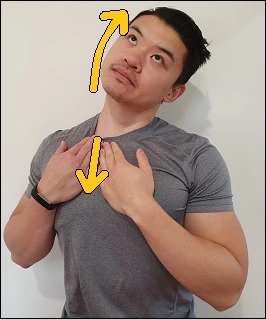
For the location of your Sternocleidomastoid muscle gently press it with two fingers – right where your collarbone is. To locate the Sternocleidomastoid muscle, simply turn your head to the side and bring your head forward. The Sternocleidomastoid muscle should come out. This muscle runs to the sternum from the collarbone (just behind your ear).
Place one hand on the opposite side of your head and place your ear on your shoulder. Be sure to hold the Sternocleidomastoid muscle over the collarbone with the other hand (two fingers) to increase the stretch. Now tilt your head up to look at the ceiling. To increase the stretch, pull your head back and to the side with your hand. hold the end range of movement for around 15-30 seconds which is necessary and you can also gradually increase the stretch duration if needed. Breathe normally during this stretch. Do both sides of the neck. If you feel pain or any discomfort avoid the stretch. If you feel pain, relieve it.
Scalene stretch
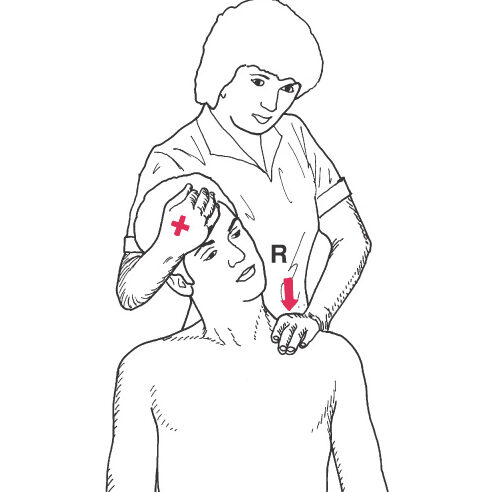
The scalene muscles are an important group of neck muscles that can easily strain and cause pain if not stretched properly. These muscles, which run along the sides of the neck, help support the head and turn it from side to side. Place your hands on top of each other directly above your sternum. Then tilt your head up and away from the painful side until you feel a slight stretch on each side of your neck.
To get the full benefit of this exercise, repeat it two or three times. Hold each position for about 30 seconds and try to complete one or two sets of each exercise. Be sure to do these exercises twice a day for the best results.
Scalene muscle stretching is a great way to bring more movement and relaxation. Scalene stretches not only keep you energized but can also improve circulation and flexibility in the neck, shoulder, and back areas of the body.
Forward head pull
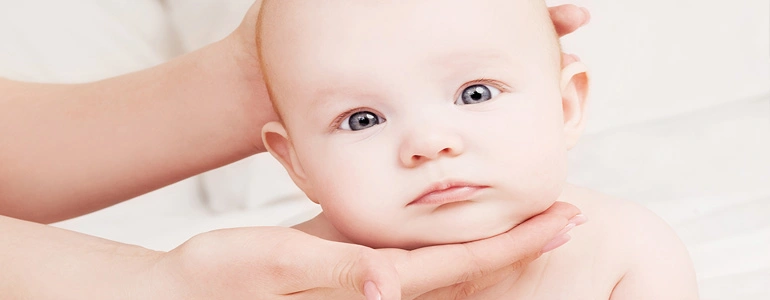
This stretch can help release the muscles that run along the back and sides of the neck. This is useful if the torticollis pulls its head back or to the side. Standing next to the counter, place your right hand behind your head. give the support to the edge of the plinth with your other hand. gradually move your head about 30 to 45 degrees to the right and then hold the position for around five to ten seconds.
You should feel tension in your neck and shoulders. If you can, gently press your head with your right hand to deepen the stretch. Hold the end range of movement for around five to ten seconds if you are comfortable you can also increase the duration of the hold. You can reverse this exercise to stretch the muscles on the other side of the neck.
Do three to five repetitions per session and do three sets per day.
Side neck rotation

This exercise allows you to turn your neck forward, making it easier for the opposite side to reach for something interesting, such as colorful toys or other objects. You will feel mild stretch sides of your neck muscle. This stretch targets the sides of your neck and helps improve your range of motion.
Keep your shoulders and hips forward during the movement. Start by looking straight ahead. Turn your head slowly to the left. Hold for ten seconds and then return to the starting position. Then gradually rotate your head to the opposite side.
Hold the end range of movement around the ten seconds. Return to the starting position. Do eight to ten repetitions per session and do three to five sets per day. This is a good exercise for recent torticollis conditions, especially if you have to hold the position it will provide a good result at the start of this condition. the side neck rotation exercises you can perform every half hour to increase the mobility of the neck joint.
Lateral bending
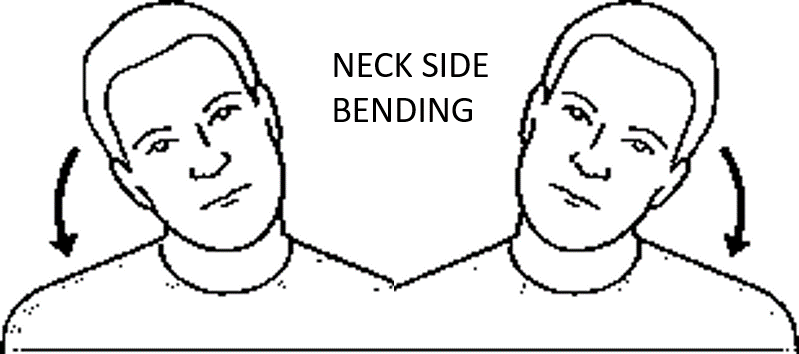
These exercises help to stretch the shoulders and sides of the neck. Start standing or sitting with your arms at your sides. Contract your abs to maintain a straight spine and pull your shoulders back and down.
Slowly bend your neck to bring your right ear to your right shoulder while keeping your shoulders in the same position. Stay in this position for five to ten seconds. Run on the left side. Do two to four repetitions on each side. You can deepen this stretch by pressing lightly on the head with your hand.
When comfortable, stretch the Sternocleidomastoid muscle muscle by gently lifting your chin as you stretch. This stretch targets the sides of your neck and helps improve your range of motion. Keep your shoulders and hips forward during the movement.
Gentle Head Rotations
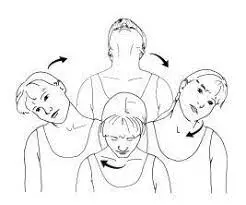
Another torticollis exercise is to put the baby on his back, the plinth is also perfect for this. If the baby tries to turn his head to the left, place your left hand on the baby’s right shoulder and keep the shoulder on the plinth or yoga mat. With your right hand, gently turn the child’s head and face to the left side.
Again, hold the stretch for five to ten seconds before letting your child relax for five to ten seconds. Repeat this five to ten times per session and perform five sets per day. For babies who have trouble turning to the right, do the opposite by placing your right hand on the baby’s left shoulder and turning the head to the right. Genital rotation of the head gives mobility to the collar joint.
Lateral Neck Flexion Strengthening
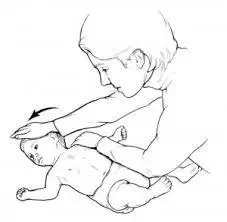
When your baby is three to four months old, he will probably hold his head up, but if he has torticollis, he may prefer to lean to the side. To strengthen one side of the baby’s neck, hold them straight and slightly bent to the other side.
The reinforced side should be more vertical. This forces your child to work to keep his head up. If the child cannot support their neck against gravity, their head may fall back to the narrow side, making the tilt worse. Adjust the angle of the baby’s body if you notice that the head is hanging down to make it easier for the baby to hold the head up. Do this every time you carry your baby to strengthen the side neck muscles.
Crib Exercises

Crib repositioning techniques are an effective way to encourage a baby’s head movement. When the child is old enough to sit, sit the child on the bed and hold or place the toy slightly above him and tilt his head to the opposite side.
This encourages your baby to turn and tilt their head and neck in a direction that promotes healthy stretching, which is beneficial for babies with torticollis.
As with the other exercises, try to hold it for five to ten seconds before removing the toy to allow the child to rest. Try to repeat this crib exercise six to ten times a day.
These simple torticollis exercises can make a world of difference to a baby with torticollis. If your child has torticollis and you are not sure what to do, it is important to seek advice from a doctor to find out how serious your child’s torticollis is and if there is anything else that can be done besides home exercises.
Tummy Exercises
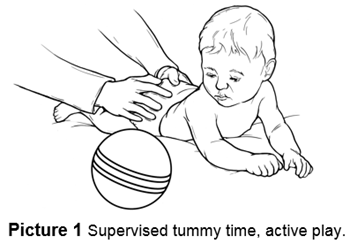
It is very important for babies to have tummy time checked at regular intervals throughout the day. A great way to help a baby with colic is to incorporate his toys into colic exercises while playing on his tummy.
Place all their toys on the unwanted side so the child tilts their head to that side. Try to get your child to hold this position for five to ten seconds before removing the toys and allowing the child to return to a comfortable position for a few seconds. Try repeating this five to ten times until your child doesn’t get frustrated.
Exercises on Therapy Ball
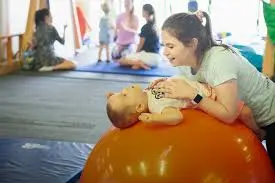
This is the strengthening exercise. This exercise Targets the muscles of the head/neck, trunk, back, and upper extremities. Be careful of strengthening exercise and imbalance and compensations as you perform these activities.
Practice tummy time on the therapy ball.
Start with the supporting child at the trunk, and gradually roll side to side and front to back.
You can place the mirror in front of the child to promote alignment as well.
Practice therapy ball work with the child seated to promote trunk strength and stability.
Lower support as the child becomes stronger.
Shoulder Shrugs
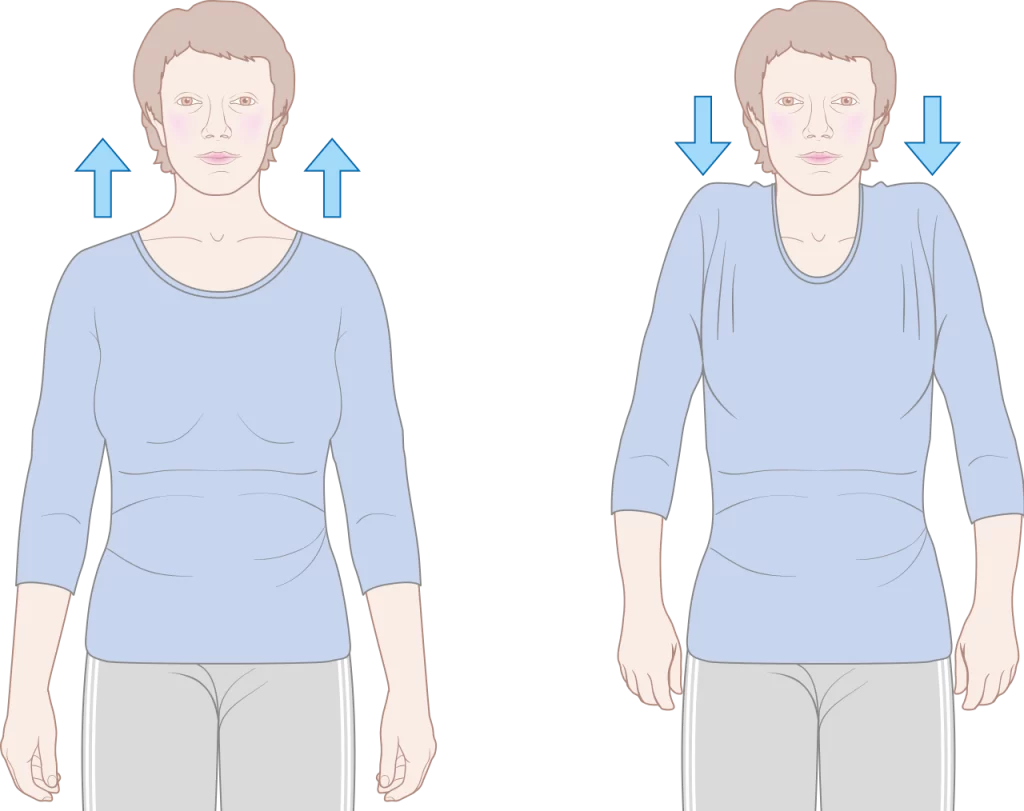
Shoulder raises are another great exercise for spastic torticollis physical therapy. To run it, follow these steps:
Sit or stand straight with your chin parallel to the floor. Slowly raise your shoulders to your ears and hold this position for five seconds. Then slowly lower them. Repeat this exercise three to five times per session and do three to five sets per day. Shrugs relax and strengthen the neck muscles.
This way you can improve your posture and reduce pain. You can include shoulder shrug exercises for the progression duration of the condition which provides a better posture for your body.
Visual exercise for torticollis
Visual Tracking
Encourage eye tracking with smooth movements to the right and left.
provide stimulation from the auditory and visual objects.
Encourage visual tracking in all developmental positions: supine, side-lying, prone, quadruped, and supported sitting.
Weight Shifting on Therapy Ball
Weight shifting via ball in supine/prone/supported sitting.
For the progression stage, you can use an incline wedge to modify the trunk strength/stability in sitting and shoulder strength/stability in prone propping.
Massage
You can start the exercises after giving a gentle massage to the baby.
the procedure is the run fingers along the muscle belly and press thumbs gently into tight spots along the sternocleidomastoid muscle (highlighted above in red). The main benefit of massage is that it reduces tightness of muscle, and increases flexibility and range of motion.
Treatment primarily involves stretching and mobilizing the sternocleidomastoid muscle, which rotates and tilts the head and tilts the head. The goal is to first relax the superficial tissues and then work deeper into the sternocleidomastoid muscle using the fingertips, knuckles, or palm to stretch longitudinally and transversely, taking care not to compress the carotid artery.
Considerations and Contraindications for Torticollis Massage Therapy
Avoid full Sternocleidomastoid muscle stretches if the vertebral artery test is positive or if the client becomes dizzy from the stretch.
Avoid the carotid artery when treating Sternocleidomastoid muscle
acutely acquired: do not passively stretch the cramp muscle
congenital torticollis – use reduced pressure for children
spasmodic torticollis- not painful technique, local rectal massage
Positioning for Play for Babies with Torticollis
The following positions are beneficial for normal development and help strengthen your baby:
shoulders, back, and core
They encourage your baby to actively move their head and neck. Hold your baby facing out or standing or sitting on your lap. Encourage your child to look to the right with toys and lights to attract their attention. Hold their body forward, hold it against yours with your right hand, and keep their head turned to the right, encouraging a gentle stretch with your left hand. Hold for 15-20 seconds, repeat 2-3 times regularly throughout the day.
Rotation (vertical)
When the baby is on his stomach, place all his toys so that he has to turn his head to the right. Start with 30 seconds once an hour and gradually increase as long as possible. Try applying a little extra pressure by placing your hands on their hips and bottom, making it easier to lift and use the baby’s head. You can put the baby’s head on the right side if he is relaxed. Never leave your child unattended in this position and always put them to sleep on their backs.
Tummy time
Place the child on his right side to play. This position allows gravity to stretch part of the neck and bring the arms to the center of the body. Bringing the hands to the midline is an important step in feeding, hand-eye coordination, and other aspects of your baby’s development.
Other Suggestions
When sleeping, place them with the head turned to the right.
Position the child so that the activities in the room prompt him to look to the right.
Try to place the baby in an upright position during feeding. Hold the baby on your shoulder and place it on the right side.
Try to avoid using a car seat except when traveling/in the car. Your therapist can show you how to use quilted baby blankets and towels to make it easier to store the child’s head in a neutral position.
Place the child on his side during play and encourage him to raise his arms to the midline to play with the toys. Place the baby on his stomach.
Place the toys to the left to help the child turn his face to the left while playing.
Carrying your child (the football hold)
Keep the child away from you. Place your right hand between the child’s legs support the child’s body and grasp the left shoulder with your right hand. Place your left arm/hand between the child’s ear and shoulder to help stretch tight muscles.
Suggestions:
Place the baby in the cradle to encourage the baby to look to the left. In the bottle/nursing position, the baby is looking to the left.
Use a towel to keep your child’s head in a neutral position (car seat, high chair, rug). If you have any questions or concerns, be sure to talk to your treating physical therapist or occupational therapist.
Helping Your Baby at Home
Encourage the child to turn his head in both directions. It helps relax tight neck muscles and tighten loose muscles. when babies are unable to their heads so they also can not try by themselves because of neck pain. Here are some exercises to try:
When a baby wants to feed, offer a bottle or breast in a way that encourages your baby to turn away from his favorite side.
When you put your baby to sleep, place him against a wall. Because babies prefer to look into the room, your baby will actively turn away from the wall and this will stretch the neck muscles. Remember – always sleep babies on their backs to prevent SIDS.
During play, attract the baby’s attention with toys and sounds so that he turns in both directions.
Medical Treatment
Non-surgical treatment
The non-surgical treatments include the medications and the physiotherapy(stretching of the SCM muscle and the scalene) Stretching exercises include e.g. Turning the child’s neck from side to side so that the chin touches both shoulders and Gently tilting the head to bring the ear from affected side down to the shoulder. These exercises should be done several times a day. Your child’s doctor or physical therapist will teach you how to do the exercises.
There are other things you can help with at home:
Place toys in places where the child has to turn his head to see them. Take your child far from the restricted side. Place the crib and changing table so that your baby has to look away from the restricted side to see you. Place your baby on his stomach for a short period awake (“tummy time”) to strengthen the neck muscles.
Surgical treatment
If non-surgical options do not improve torticollis, your child’s doctor may recommend surgery.
About 10% of children with congenital muscular torticollis require surgery. The operation is usually planned when the child reaches preschool age. The procedure, which lengthens the short sternocleidomastoid muscle, can be done as an outpatient procedure, allowing your child to go home the same day.
Benefits of physical therapy for Torticollis condition
This physical therapy stretches and exercises are simple postural changes that can be done at home to help build your child’s neck muscles and create preventative habits.
Range of motion
If the baby prefers to roll his head in one direction when the baby is born, consciously hold the baby on the chest, turning the head in the opposite direction for a gentle and easy stretch. Ask a licensed pediatric physical therapist for guidance on other torticollis stretches based on your child’s level of damage and tolerance for neck stretches.
Strengthening exercises
At Samrapan Physiotherapy Clinic, we offer physiotherapy for babies for the treatment of torticollis and other diagnoses. Read more about Torticollis physiotherapy in this blog! Tummy time with a therapy ball rocking from side to side and front to back. Toys, mirrors, pets, siblings, etc. can be used to encourage the child to look away from the restricted side. Sit on the therapy ball to improve core strength and stability, roll from side to side/front to back, and have the child work to return to a sitting position.
Place baby on a soft wedge/cramp or pillow (Boppy works well) to slow tummy time to encourage head movement and arm weight. Increase the challenge by reducing the size of the support (pillow → diaper cover on roll → small towel roll)
Sitting activities
the child usually bends with the body or falls from the shorter side to the longer side; place the toy on the shorter side to encourage weight shift to the tighter side and muscle rotation to the weaker side.
Positioning/handling
sleeping and playing surfaces; limit time spent on swings, bouncers, and soft surfaces to 15-20 minutes as they restrict head and body movement and promote poor posture if overused.
The side sleeping position is perfect for lifting your baby off your back and bringing your hands to the center of the body to play midline. Use a roll of towels or a pillow to help them stay in this position.
Football hold (side carry)
Hold the baby with the hand between the legs and the hand under the stomach, with the shoulder on the shortened side of the neck. In this position, they try to hold their head up and strengthen the long and weak sides while stretching the short side. Hold the baby in front of you and far away – takes the weight off the head and helps strengthen the neck. In the carrier, the child should be kept facing inward until he has good head control and is able to position himself.
Alignment/Position
Transferring body weight onto the ball: lying on the back or stomach or sitting on the ball.
When you lift the baby from the floor, baby, or changing table, first take the baby on its side and then lift it; switch sides regularly. In this blog, we share physical therapy exercises and posture tips for children and babies with torticollis.
The environment
When you put your baby to sleep, turn his head so that he is not always looking in one direction. Another way to promote this is to lay the baby so that the head is at a different end of the crib each day. Switch sides every time you bottle feed (feeding happens automatically when breastfeeding!) and switch which hip you hold your baby on. Avoid leaving the child in a car seat, booster seat, swing, tray, etc., where the head is likely to rest in one place. Tummy time: Place toys away from the shortened side to encourage the baby to turn his head to the other side.
Living with Torticollis condition:
Torticollis is the reason a minor injury or illness is sometimes temporary and treatable. There are, congenital and more severe types of torticollis conditions that can become reasons for long-term health problems. Chronic torticollis can cause complications, including:
swollen neck muscles
Neurological symptoms from compressed nerves
Chronic pain
difficulty performing routine tasks
an inability to drive
difficulty socializing
isolation
Depression
Precaution while exercising for a baby
Work carefully within your child’s tolerance.
Slowly increase the movement over time.
Find the best position and time for your baby.
Hold these light stretches for about 30 seconds.
Stop stressing faster if the child starts to resist the movements or becomes grumpy.
You should never feel like you are forcing the movement.
If the child is very relaxed, you can hold the stretch for up to one minute.
Use your voice or favorite toys to entertain and calm your child.
Repeat these stretches often throughout the day: during playtime, after bath, and/or at each diaper change. Aim for eight times a day with every two stretches.
Hold these light stretches for about 30 seconds. Stop stretching earlier if the child starts to resist the movement or becomes grumpy.
How can I prevent torticollis?
You can reduce your risk of neck pain by trying the following tips:
Improve your posture with gentle stretches or try a yoga or pilates class.
If you work at a desk, arrange your workspace so that the desk and chair meet your needs.
Use a footrest if you notice that your knees and hips are not level and your feet are not flat on the ground.
You may also need to move items you use regularly closer to you so you don’t have to twist and reach too far to find the items you need.
Support your neck with a supportive pillow when you sleep and sleep on only one pillow. Adjust the headrest in the car so that it is at least at eye level and as close to the back of the head as possible.
Do not drive if you cannot turn your head freely. Use headphones or speakerphone and don’t put the phone between your shoulder and ear.
Is my torticollis a sign of serious disease?
Very rarely, torticollis can be a sign that you have a more serious condition, such as an infection, abscess, tumor in the head or neck, or a neck injury. See your doctor right away if you have torticollis accompanied by any of the following symptoms:
fever
headache
Double vision
light sensitivity
difficulty maintaining balance while walking
Torticollis self-treatment
Diaphragmatic breathing
Self-extending Sternocleidomastoid muscle, scalene, trapezium
A chiropractor can help with subluxations
How Long Before We Notice a Difference?
Working closely with a physical therapist and doing daily exercises for your child can help improve your child’s head and neck movement. In most cases, you can notice great changes within a few weeks of starting stretching and passive exercises.
You can expect your child’s torticollis to resolve within three to six months. If your child’s signs and symptoms persist, you should see your pediatrician to discuss other treatment options. Sometimes Botox injections may be recommended to relieve spasmodic muscles. In rare cases, some babies with this condition require a surgical procedure to lengthen the shortened muscle(sternocleidomastoid muscle).
Remember that torticollis can “come back” as an old motor pattern when a child learns a challenging new skill (like crawling or walking). It is normal. Contact your physical therapist as they may have another session to correct this.
How to Build the Strategy to Do Exercises for Torticollis
Creating a strategy for training with cervical dystonia is crucial. here are some tips for making the strategy for the exercise tips include:
Set aside time each day to do torticollis exercises. Do them in the morning and evening or at least once a day.
If the exercises cause pain, stop them immediately and consult a doctor. Remember to take regular breaks between exercises. This allows your muscles to relax and recover from tension. Gradually increase the intensity of the torticollis exercises.
When you strengthen your neck muscles, you can do more. Try stretching your torticollis, such as yoga or pilates. This way you can strengthen your neck muscles even more.
Your doctor may recommend physical therapists or other health care providers. They can provide advice and support on torticollis exercises. It is important to follow a training program to achieve the best results. If the neck is still stiff and painful, consult a specialist.
What Kind of Physical Therapist Do I Need?
All physical therapists are trained through training and experience to assess, manage, and treat a variety of conditions, including torticollis. You may want to see:
Pediatric physiotherapist with experience in the treatment of torticollis in babies and children. A physical therapist who is a board-certified pediatric physical therapy clinical specialist or who has completed a pediatric physical therapy residency or fellowship. This physiotherapist has a high level of knowledge, experience, and skills that can apply to your child’s condition. With this information and clinical expertise, you can find physical therapists in your area using the Find a PT tool created by the American Physical Therapy Association. General tips for finding a physical therapist (or other health care provider):
Get a referral from family, friends, or other healthcare providers.
Before booking an appointment, ask your physiotherapist about their experience with torticollis treatment.
Be prepared to describe your child’s birth history and symptoms in as much detail as possible.
A note from Samarpan Physiotherapy clinic
Torticollis, or simply twisted neck, is a condition in which the head remains tilted to one side. Infantile torticollis is caused by a strained neck muscle. Usually, the child tilts his ear to one shoulder and his face to the opposite side. Some babies are born with torticollis, but it usually develops after birth. Baby colic can be caused by the baby’s position in the womb or by spending too much time on their back or in containers such as car seats and swings. Up to 16% of newborns (1/6) suffer from torticollis. Plagiocephaly and torticollis often occur together. Infantile torticollis responds very well to physical therapy. The earlier the treatment starts, the faster and more completely it can be removed.
Physical therapists are movement experts who use the latest evidence to develop treatment plans for each individual’s needs and goals. They improve quality of life through hands-on care, patient education, and prescribed exercises. You can contact our clinic directly or one of our physiotherapists for an assessment. physical therapist to restore neck movement and provide flexibility in the tight neck muscles.
FAQ
The therapist will also teach you stretching and posture exercises that you do every day at home with your child. The goals of physical therapy for torticollis are to: Improve your child’s ability to turn his head from right to left. Improve your baby’s ability to bring the chin to the chest.
You can usually treat torticollis with a heat pack, pain reliever, and neck massage. If your baby has torticollis, ask for advice on how to position him during feeding and sleeping. You can also learn to gently move your head to encourage the neck to stretch.
SCM stretch, neck side rotation, lateral bending, head movement
Place one hand on the child’s left shoulder. It holds the shoulder. Place the other hand on the left side of the child’s face (from the forehead to the chin). Carefully and slowly turn the baby’s face to the baby’s right shoulder.
Torticollis is a fairly common disease in babies and children. Stretching the baby’s neck and turning the baby’s head can usually treat the condition. Within a few months, you should notice an improvement in your child’s condition. If treatment is started early, they should not have long-term problems.
Temporary torticollis
This temporary problem sometimes occurs when your child’s lymph nodes are warm and swollen (inflamed) after an ear infection or a cold. Torticollis can also develop when your child hurts his head or neck. The joints between the neck bones swell and become painful.
Providing massage therapy to infants with congenital muscular torticollis is a safe and effective way to improve cervical mobility and function.
In most cases, it is a muscle problem that can be easily fixed. Other times, the disease is caused by an infection or a neurological problem. A genetic mutation can make some people more susceptible to the disease. Whether it occurs in infants, children, or adults, torticollis can be treated.
References
C. (n.d.). Torticollis (Wryneck): Symptoms, Causes & Treatment. Cleveland Clinic. https://my.clevelandclinic.org/health/diseases/22430-torticollis
(NASM-CPT, NASM-CES), L. T. (2019, May 2). Easy Sternocleidomastoid Stretch (SCM) – Posture Correction Must-Do. Back Intelligence. https://backintelligence.com/sternocleidomastoid-stretch/
How to Stretch Your Neck: Techniques and More. (n.d.). How to Stretch Your Neck: Techniques and More. https://www.healthline.com/health/how-to-stretch-neck
PT, DPT, C. P. (2020, February 21). The Ins and Outs of Physical Therapy for Torticollis – NAPA Center. NAPA. https://napacenter.org/torticollis-physical-therapy/
Torticollis | Boston Children’s Hospital. (n.d.). https://www.childrenshospital.org/conditions/torticollis#:~:text=Congenital%20muscular%20torticollis,-The%20child%20has&text=The%20head%20tilts%20to%20one,plagiocephaly%2C%20may%20also%20be%20present.
Pt, B. S. (2021, December 17). The Benefits of Physical Therapy for Torticollis in Children. Verywell Health. https://www.verywellhealth.com/physical-therapy-for-torticollis-in-children-5208744
Guide | Physical Therapy Guide to Torticollis. (2022, June 18). Choose PT. https://www.choosept.com/guide/physical-therapy-guide-torticollis
Dhanyamraju, S., & Dhanyamraju, S. (2023, July 3). Best Exercises for Cervical Dystonia. Lone Star Neurology. https://lonestarneurology.net/blog/cervical-dystonia-exercises/

